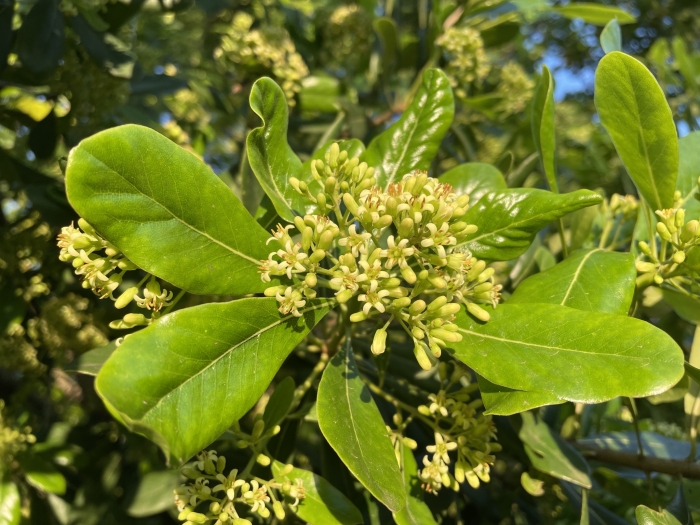Cape Cheesewood
(Pittosporum viridiflorum)
Cape Cheesewood (Pittosporum viridiflorum)
/
/

Robert Taylor
CC BY 4.0
Image By:
Robert Taylor
Recorded By:
Copyright:
CC BY 4.0
Copyright Notice:
Photo by: Robert Taylor | License Type: CC BY 4.0 | License URL: http://creativecommons.org/licenses/by/4.0/ | Rights Holder: Robert Taylor | Publisher: iNaturalist | Date Created: 2021-10-23T03:52:18Z |

























Estimated Native Range
Summary
Pittosporum viridiflorum, commonly known as Cape cheesewood, is an evergreen tree native to a range of habitats including montane forests, evergreen bushlands, and coastal forests in Sub-Saharan Africa. It thrives at elevations from 2133 to 8530 feet and can reach up to 33 feet in height with a similar spread. The tree’s appearance is characterized by its dense, rounded canopy, glossy green obovate leaves, and small, fragrant, yellow-green flowers that bloom in the spring. The flowers are followed by woody, dehiscent capsules containing bright red seeds, which are particularly decorative and can persist on the tree, adding to its ornamental value.
Cape cheesewood is valued for its hardy nature and is often used in gardens and landscapes for screening or as a specimen tree. It is drought-tolerant once established, making it suitable for xeriscaping and water-wise gardens. The tree prefers well-drained soils and can tolerate a range of soil types, from sandy to loamy. It requires full sun to part shade and moderate watering, with reduced watering during the winter months. While it is generally pest-resistant, it can be susceptible to scale insects and sooty mold. In traditional medicine, various parts of the plant are used for their purported health benefits, and the wood is utilized for carving and craftwork.CC BY-SA 4.0
Cape cheesewood is valued for its hardy nature and is often used in gardens and landscapes for screening or as a specimen tree. It is drought-tolerant once established, making it suitable for xeriscaping and water-wise gardens. The tree prefers well-drained soils and can tolerate a range of soil types, from sandy to loamy. It requires full sun to part shade and moderate watering, with reduced watering during the winter months. While it is generally pest-resistant, it can be susceptible to scale insects and sooty mold. In traditional medicine, various parts of the plant are used for their purported health benefits, and the wood is utilized for carving and craftwork.CC BY-SA 4.0
Plant Description
- Plant Type: Shrub, Tree
- Height: 9.75-25 feet
- Width: 9.75-20 feet
- Growth Rate: Moderate
- Flower Color: N/A
- Flowering Season: Spring
- Leaf Retention: Evergreen
Growth Requirements
- Sun: Full Sun, Part Shade
- Water: Medium
- Drainage: Fast, Medium
Common Uses
Bird Garden, Low Maintenance
Natural Habitat
native to a range of habitats including montane forests, evergreen bushlands, and coastal forests in Sub-Saharan Africa
Other Names
Common Names: Cheesewood, Cape Pittosporum, White Cape Beech, Spoor, Kasuur
Scientific Names: , Pittosporum viridiflorum, Pittosporum abyssinicum var. angolense, Pittosporum antunesii, Pittosporum arbutifolium, Pittosporum capense, Pittosporum commutatum, Pittosporum dalzielii, Pittosporum feddeanum, Pittosporum kapiriense
GBIF Accepted Name: